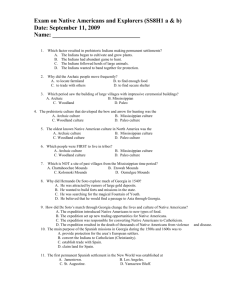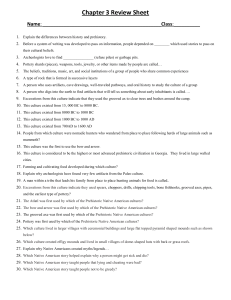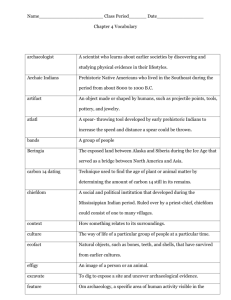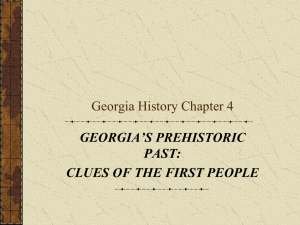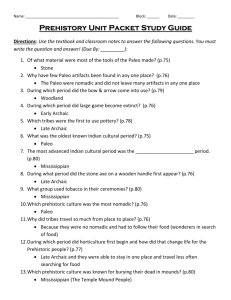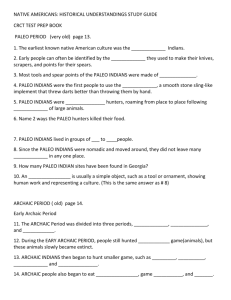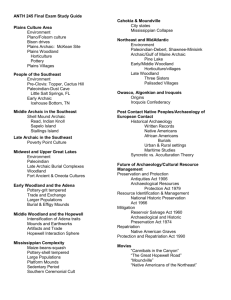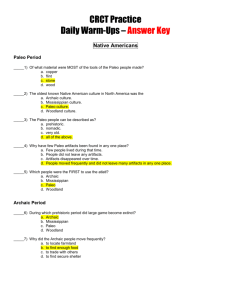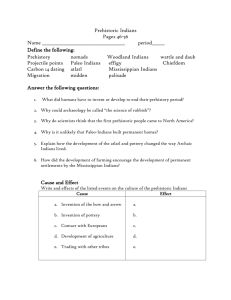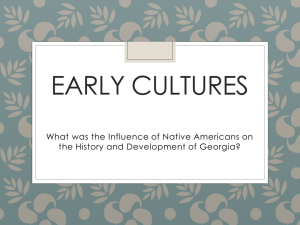Chapter 3:
advertisement
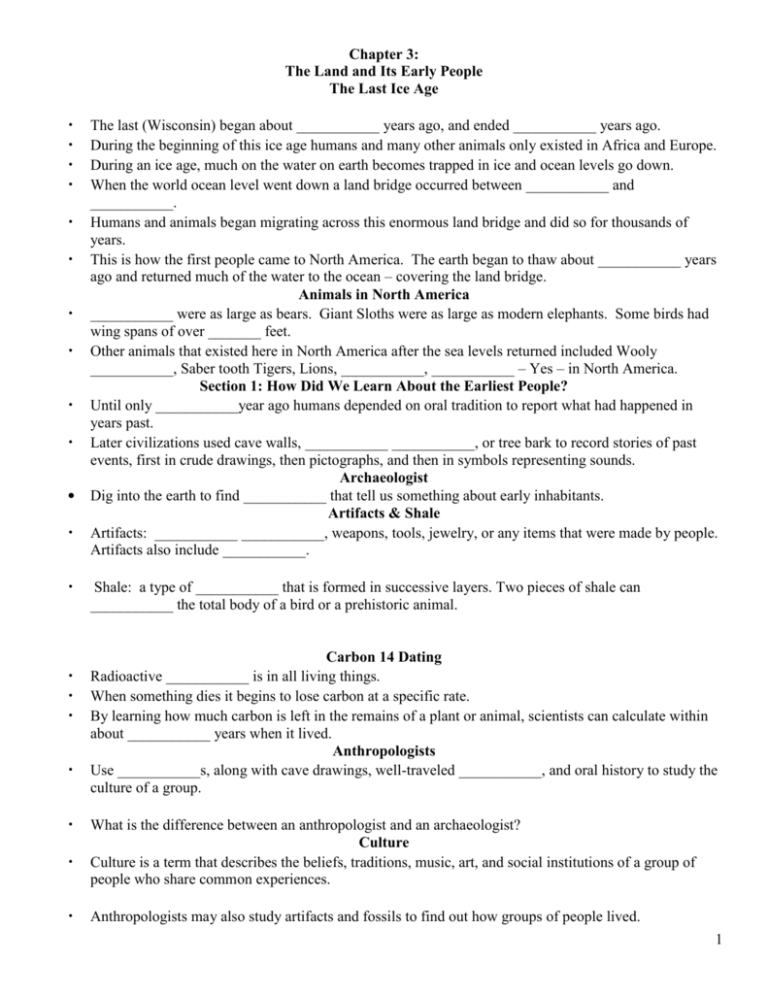
Chapter 3: The Land and Its Early People The Last Ice Age • • • • • • • • • • • • • • • • • • The last (Wisconsin) began about ___________ years ago, and ended ___________ years ago. During the beginning of this ice age humans and many other animals only existed in Africa and Europe. During an ice age, much on the water on earth becomes trapped in ice and ocean levels go down. When the world ocean level went down a land bridge occurred between ___________ and ___________. Humans and animals began migrating across this enormous land bridge and did so for thousands of years. This is how the first people came to North America. The earth began to thaw about ___________ years ago and returned much of the water to the ocean – covering the land bridge. Animals in North America ___________ were as large as bears. Giant Sloths were as large as modern elephants. Some birds had wing spans of over _______ feet. Other animals that existed here in North America after the sea levels returned included Wooly ___________, Saber tooth Tigers, Lions, ___________, ___________ – Yes – in North America. Section 1: How Did We Learn About the Earliest People? Until only ___________year ago humans depended on oral tradition to report what had happened in years past. Later civilizations used cave walls, ___________ ___________, or tree bark to record stories of past events, first in crude drawings, then pictographs, and then in symbols representing sounds. Archaeologist Dig into the earth to find ___________ that tell us something about early inhabitants. Artifacts & Shale Artifacts: ___________ ___________, weapons, tools, jewelry, or any items that were made by people. Artifacts also include ___________. Shale: a type of ___________ that is formed in successive layers. Two pieces of shale can ___________ the total body of a bird or a prehistoric animal. Carbon 14 Dating Radioactive ___________ is in all living things. When something dies it begins to lose carbon at a specific rate. By learning how much carbon is left in the remains of a plant or animal, scientists can calculate within about ___________ years when it lived. Anthropologists Use ___________s, along with cave drawings, well-traveled ___________, and oral history to study the culture of a group. • What is the difference between an anthropologist and an archaeologist? Culture Culture is a term that describes the beliefs, traditions, music, art, and social institutions of a group of people who share common experiences. • Anthropologists may also study artifacts and fossils to find out how groups of people lived. 1 • • • • • • • • • • • • • • • • • • • • • • Did You Know? B.C. stands for “___________ ___________” and means the number of years before the birth of Jesus Christ. A.D. means “____________ __________” which is ___________ for “in the year of our Lord.” Prehistoric People Early people are identified by ___________ periods. No two cultures were exactly alike and changes took place slowly. Archaeologists have grouped people into the following cultures: ____________________ ____________________ ____________________ ____________________ Paleo Indians (30,000 B.C. – 8,000 B.C.) we think The earliest known culture is that of the _____________ _____________, whose culture began when the first human beings migrated into North America (around _____________ B.C. ) and lasted until about 10,000 years ago. The word Paleo comes from the Greek and means _____________ _____________ or long ago. Because most tools and spear points used by the people of this culture were made of stone, this period is referred to as the ____________________ (old stone) age. What defines the Paleo Indian Period __________________ __________________ bands of 25-50 people Short lifespan males _____; females a little older Clovis Clovis points were made by Paleo Indian _____________. These hunters stalked game with these points and often times surrounded mammoths, mastodons, and other large game forcing them to jump off _____________ in order to kill them. Archaeologists believe the points were hafted to short shafts, which in turn were mounted into sockets on heavier spear shafts. This provided for "_____________" spears! The spear could be thrown by hand or with the aid of the _____________. Difficult Nomadic Life Because Paleo Indians were nomads and moved around a lot it has been hard to find a lot of _____________ that give us a lot of information on them. However, from what we know these folks had very difficult lives, only living to the age of around 25 for males and a little longer for females. The animals that they had to kill and live off of were very big (mammoths, mastodons, giant sloths, etc…) and were _________________ to hunt. Also, these people were not at the top of the food chain and were often _____________ themselves. Food could be scarce and _____________ conflicts were a daily issue. Humans were very violent towards each other. Archaic Indians (8,000 B.C. – 1,000 B.C.) The Archaic period (from the word archaic, meaning “_____________” included three distinct time spans: _____________, _____________, and _____________. What defines the Archaic Indian Period ________________________ Large animals become _____________ _____________ life ends 2 • • • • • • • • • • • • • • • • • • • • • • • • • Primitive to sophisticated _____________ ________________________ Pottery and cooking/storing food Atlatl Atlatl- A smooth _____________ sling-like implement that threw darts far more accurately than if they were thrown by hand. It enabled the Paleo hunters to _____________ animals for food from far away rather than forcing them to get too close to their prey. (which may kill them) Early Archaic Period During the early Archaic period, from about 8,000 BC to about 5,000 BC, the people still hunted _____________ game. The problem was that these animals were becoming extinct because of ________________________ Archaic Indians began hunting smaller animals, such as _____________, bear, turkey and _____________. Dealing with Change Hunters made their spears and points _____________ for the new game. They also began to eat reptile, game birds, and _____________. Early Archaic began inventing primitive tools from stone and bones and _____________ with each other. Archaic people during this period continued to move but mostly ________________ to where the best food could be found during that season. Middle Archaic Period Geographers tell us that by 5000 BC, when the middle Archaic period began, the area grew _____________ and _____________. Water levels along rivers and coastal areas receded, and the people began to eat ___________________, such as mussels and _____________. Scientists have found hooks made from animal bones. Hunting became easier, getting food became easier and people didn’t have to move so much during this period. Late Archaic Period A common artifact from the late Archaic period (4000 BC to 1000 BC) is the grooved _____________. Indians made this tool by putting a stone axe head on a wooden handle. They used the axes to clear trees and brush to make ________________. People figured out how to cultivate plants and trees and grow gardens. They also figured out to how to domesticate ________________ and keep them around so that they didn’t have to chase them around to kill them. This means that people began setting up permanent villages. An Important Event The discovery of _______________________, the science of cultivating plants, was one of the most important discoveries of all time!!! By 2500 BC, the climate had become cooler and wetter, much like the climate of GA today. Water filled rivers, streams, and lakes. Middens Shell fish became such a popular thing to eat that large groups of Late Archaic Indians would gather at different location along the coast of Georgia. These big eating parties resulted in HUGE piles of discarded ________________. These large mounds, called ________________, still exist today. A New Way to Cook 3 • • The way food was prepared also changed. Pottery shards dating from this period indicate that clay containers were used for storing, cooking and serving food. Pottery was one of the greatest contributions the Archaic Indians made to Native American culture. • Woodland Indians (1,000 B.C. – 1,000 A.D.) The Woodland Indian period lasted only ________________ years; however, the natives alive during this time made some major accomplishments. What defines the Woodland Indian Period Tribes develop ________________ • Pottery becomes ________________ and useful • ________________ ceremonies begin • ________________ and burial mounds are built Woodland Indian Period The first tribes begin to develop Tribe: A group of people that share a common ________________, name and way of life. Because of archaeological finds called post molds we know that the Woodland people lived in domeshaper homes and established villages. Woodland Way of Life Fishing, hunting, picking berries and growing some vegetables made food very easy to have. The Woodland people also figured out how to make pottery last longer by using ________________ and by baking the pottery in a fire (first ________________) making it hard enough to cook with Woodland Religion Religious ceremonies began and became very elaborate as ideas spread through ________________. Woodland people built burial mounds and adorned their dead with riches – indicating that they believed in an ________________. Woodland Indians also created effigies like Rock Eagle. • • • • • • • • • Mississippian Period (700 A.D. – 1540 A.D.) Known to be the highest prehistoric civilization in Georgia (the most complex and functional civilization before written records). What defines the Mississippian Indian Period • Sophisticated gardens, ________________ ________________and store-houses • Elaborate villages with ________________, motes and religious temples • Complex religious, political and government organization within the villages (________________) Mississippian Way of Life The Mississippian Indians grew most of their food from gardens (pumpkins, maize or corn, squash, beans, etc…) and supplemented their diets with meats. They had figured out the complex idea and invention of crop rotation. Mississippian Style These Indians dressed up, fixed their hair in different ways and wore beads and other jewelry. They typically had body art and ________________. • • • • 4 • • • • • • • • • • • Mississippian Communities Mississippian Indians lived in massive villages with sometimes thousands of families. They were very religious and built large religious temples on ______________________ mounds that their priest/chief usually lived in. They developed ____________________, political and social organizations called chiefdoms – where the priest/chief was ruler. A chiefdom may include several villages. Mississippian War Mississippian villages were often surrounded by ________________ and palisades (________________ fences). They usually had guard towers. What does this tell you about what was probably taking place during this time? The End of Prehistoric America Hernando de Soto began exploring in this region around ________________. The Native Americans here vanished within 60 years of his explorations. Because this was a ________________ period we may never know why. Why do you think these Native Americans disappeared? Prehistoric Economics Discussion: Directions: In your table groups discuss and write the answers to the following questions. Over time, how did early people adapt to solve the problem of a scarcity of food? 1. How the changes in technology from spear, to atatl, to bow and arrow improve productivity? Did these changes come slowly or quickly? [Hint: Compute the length of each cultural time period.] 2. What evidence is there of early people being able to specialize in doing activities which made life better for the whole society? 3. Across time, what types of natural resources did early people use to provide shelter? 5
